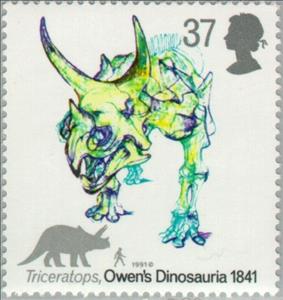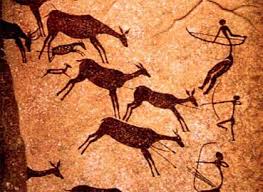Stamp: Triceratops (United Kingdom of Great Britain & Northern Ireland 1991)
Triceratops (United Kingdom of Great Britain & Northern Ireland 1991)
20 August (United Kingdom of Great Britain & Northern Ireland ) within release Anniversary of Dinosaurs' Identification goes into circulation Stamp Triceratops face value 37 British penny
| Stamp Triceratops in catalogues | |
|---|---|
| Michel: | Mi:GB 1354 |
| Yvert et Tellier: | Yt:GB 1560 |
| Stanley Gibbons: | Sg:GB 1577 |
| AFA number: | AFA:GB 1490 |
Stamp is vertical format.
Also in the issue Anniversary of Dinosaurs' Identification:
- Stamp - Iguanodon; Owen's Dinosauria 1841 face value 22;
- Stamp - Stegosaurus face value 26;
- Stamp - Tyrannosaurus face value 31;
- Stamp - Protoceratops face value 33;
- Stamp - Triceratops face value 37;
Stamp Triceratops it reflects the thematic directions:
Prehistory, also called pre-literary history, is the period of human history between the first known use of stone tools by hominins c. 3.3 million years ago and the beginning of recorded history with the invention of writing systems. The use of symbols, marks, and images appears very early among humans, but the earliest known writing systems appeared c. 5,200 years ago. It took thousands of years for writing systems to be widely adopted, with writing spreading to almost all cultures by the 19th century. The end of prehistory therefore came at different times in different places, and the term is less often used in discussing societies where prehistory ended relatively recently.
Dinosaurs are a diverse group of reptiles of the clade Dinosauria. They first appeared during the Triassic period, between 243 and 233.23 million years ago (mya), although the exact origin and timing of the evolution of dinosaurs is a subject of active research. They became the dominant terrestrial vertebrates after the Triassic–Jurassic extinction event 201.3 mya and their dominance continued throughout the Jurassic and Cretaceous periods. The fossil record shows that birds are feathered dinosaurs, having evolved from earlier theropods during the Late Jurassic epoch, and are the only dinosaur lineage known to have survived the Cretaceous–Paleogene extinction event approximately 66 mya. Dinosaurs can therefore be divided into avian dinosaurs—birds—and the extinct non-avian dinosaurs, which are all dinosaurs other than birds.


